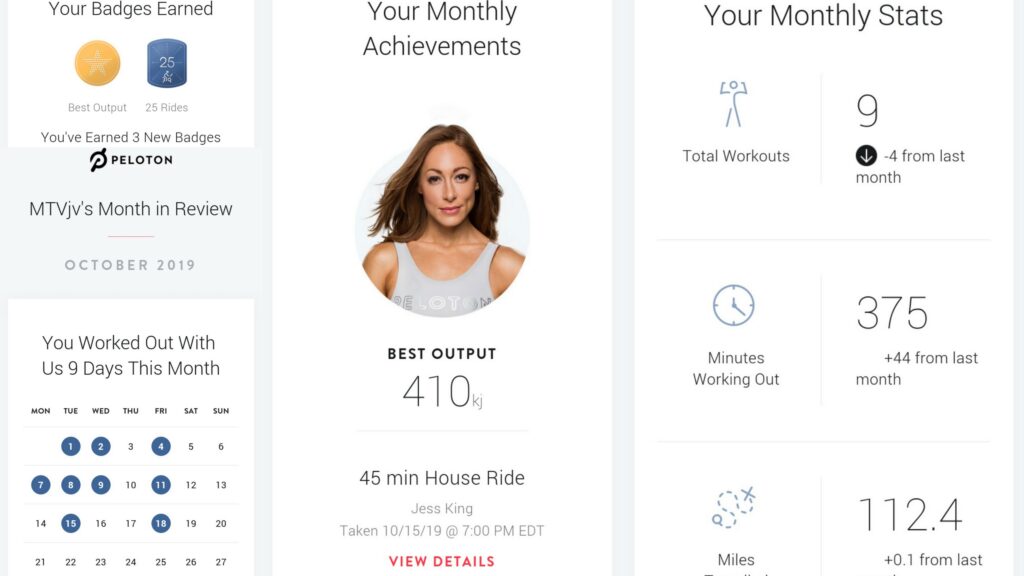Over the past 3 months I’ve been devoting between 3-4 hours a week to one of the two Peloton bikes at my work’s fitness center. When I’m on the bike, I’m plugged in and fully engaging my body and mind. When I’m off the bike, I’m thinking about the next time I’ll be able to ride and speaking to the virtues of the experience. Now while not an actual cult, the marketing & product teams at Peloton knew what they were doing. This excessive admiration is shared by many, but why? Here’s what I think…
Hardware – The pedal strokes are smooth, resistance knob is well placed and generous on climbs & downhills, handles are sturdy, and the almost too large touchscreen is everything you’d expect in a premium piece of tech. The range in which users can adjust saddle height & depth, and handles are also very impressive. I crave function in most everything in my life, and this bike nails it (even better than the Keiser m3 that’s in my garage). In addition to function, Peloton appeals to the form loving side of me too. I can totally see this in the custom raised platform in my 2nd living room of my NYC penthouse some day (see this story on Clue Heywood’s Twitter for context). Enough of the commoditized components, let’s get into the real differentiatiors…
Content – Live and on-demand spin classes separates Peloton from any other traditional spin bike. The variety of classes by duration, music genre, rider experience, and workout type is incredible. This makes it one of the most flexible workout experiences as it works around how much time you have, your desired sweat, and your overall mood. You can’t however have a class without…
Instructors – My generation is witnessing a shift in how celebrities are born. The atomic levels of energy, personality, and connection that instructors like Jess King exude are what makes the rides so incredible and unique. Eye contact, calling out riders for reaching ride milestones (e.g., century or 100 rides), and verbal motivation are all designed to keep riders engaged and moving. In addition to these rising stars I’ve been seeing more entertainers like Jennifer Lopez and P!nk co-riding, which undoubtedly attracts even more subscribers to Peloton’s service.
Data – I’ve been an analyst by title a few times in my professional career, but data is a part of my everyday life. Never have I ever had this level of access to my output during any physical workout. I understand this is nothing new, Orange Theory has been doing it for years. For me personally, the data that’s available on screen while biking (including the cadence and resistance thresholds) and after rides (detailed output stats, streak info, gamified acheivements, monthly updates, etc.) make for a richer experience. I just got my October month in review, check this out…

Access to data is nice, but what do I do with it? First thing, I hold myself accountable. The fact that I was on an 8 week streak is awesome and it keeps me going. Second, I’m able to tell the story of my improvement and ability through data, which also keeps me motivated.
Social – Jumping on a spin bike in a gym/your basement/office is no longer a solitary activity. You’re connected to riders that are taking classes at the same time as you, live or on demand. Interactions with other riders includes high fives and even video chat (however I haven’t tried this yet).
That’s all well and good, but what about the bad?
Price – One of the major hurdles the price tag, which is both the bike ($2,245) and monthly subscription ($39/month). Let’s be real, in addition to the actual bike and classes, you’re paying for convenience.
I think it’s pretty telling that this is the only downside I can see right now. I started to write about Fatigue (e.g., getting tired of the classes in addition to getting bored with spin) and Motivation (e.g., avoiding the dreaded clothes rack), but both of these conditions are up to me and not the bike.
So what’s next for Peloton? They went public a few weeks ago, and it’s been a rough ride. They are operating at large loss, lower cost alternatives are flooding the market, etc. However, speaking as a cult follower, they have a rabid user base. Metrics like DAU and MAU are used to measure the engagement of users, which I’m pretty sure will be part of public reports, however, satisfaction of the product (the bike) and service (content, data, etc.) as a whole, is what I believe will enable Peloton to succeed. The partnerships with celebrities & athletes will help their user base expand and I expect to see both expected and unexpected media figures join the classes. Incorporating additional activities like yoga, stretching, lifting, running will also help grow their base.
Since starting to write this blog post (well over a week ago), I’ve actually taken a bit of time off from the Peloton (travelling for work, manageable back injury). However, the gym bag is by the front door and I’m ready to rock!
